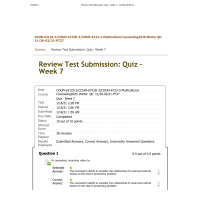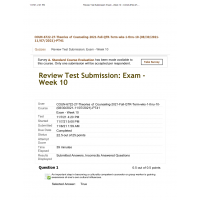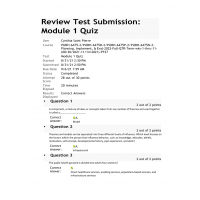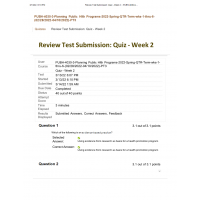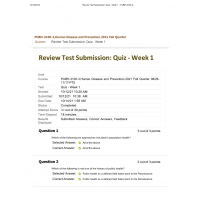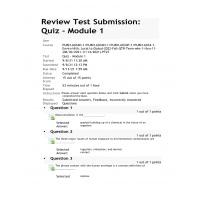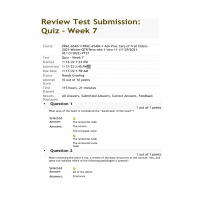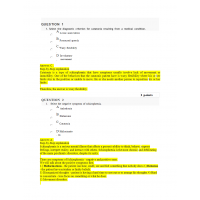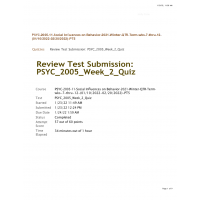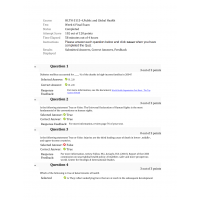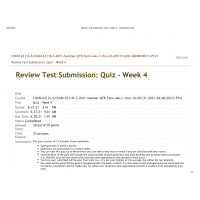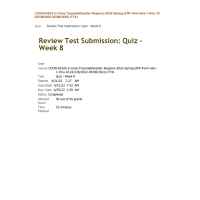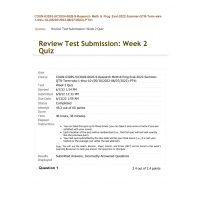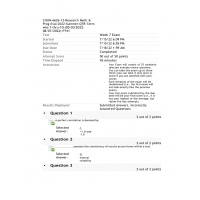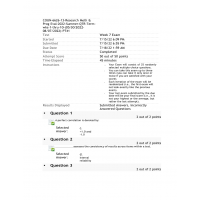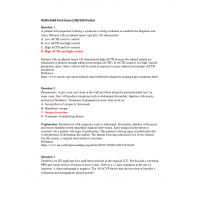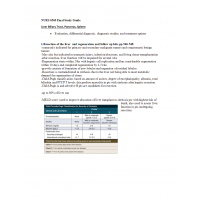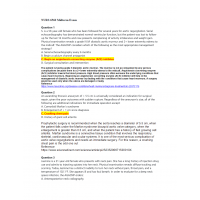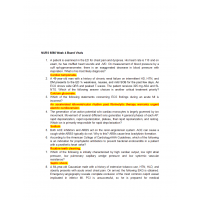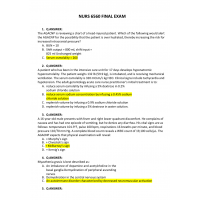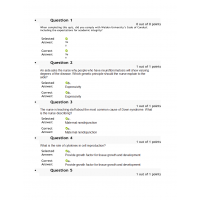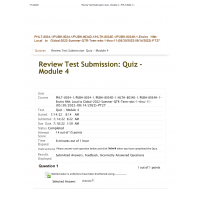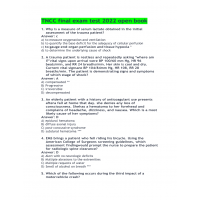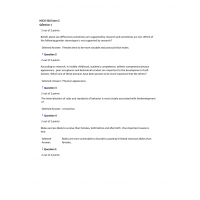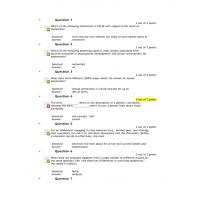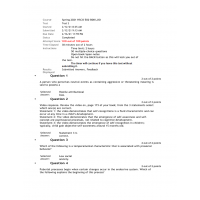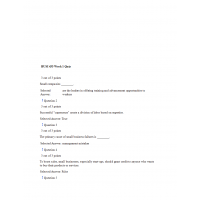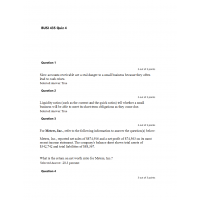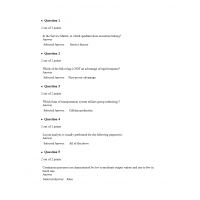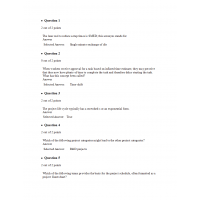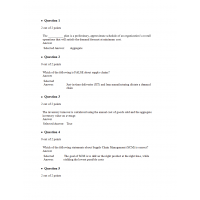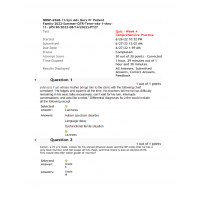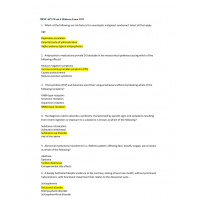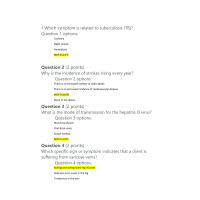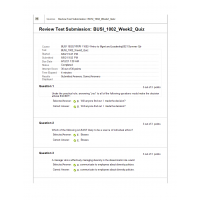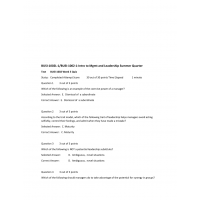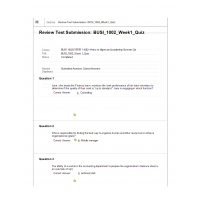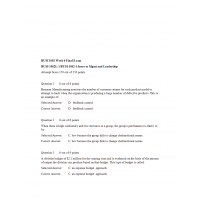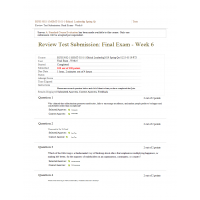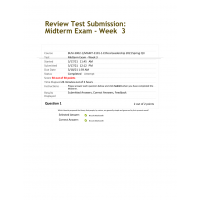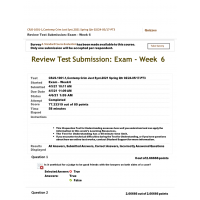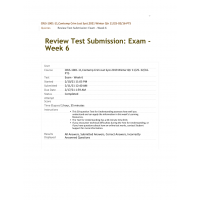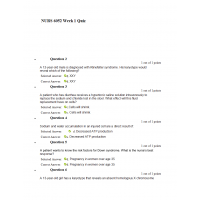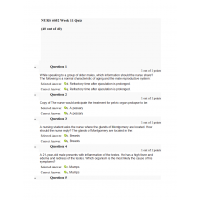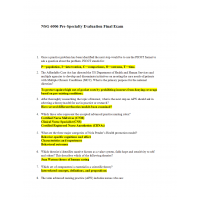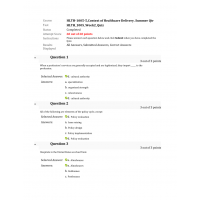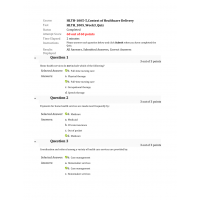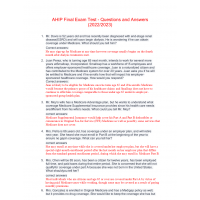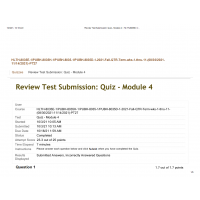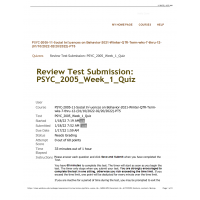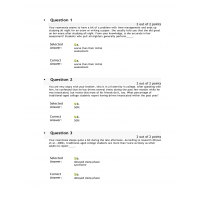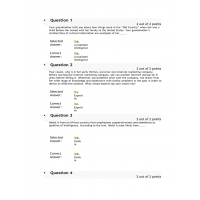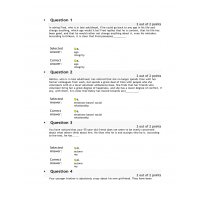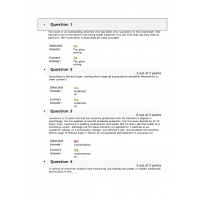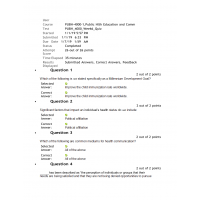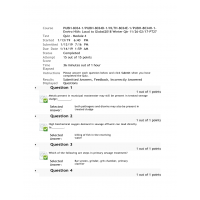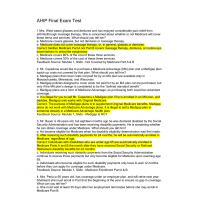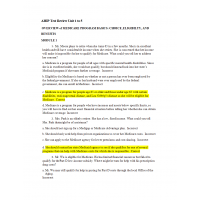NUR 2063 Essentials of Pathophysiology Exam 1 Rasmussen
NUR 2063 Exam 1 Review
1. Which of the following assessment findings indicates an alteration in homeostatic control mechanisms?
2. Injury that occurs when blood flow is diminished to tissue is called injury.
3. The cancer growth continuum is divided into which of the following stages?
4. The activities of the cell are directed by which cell structure?
5. Enzymes that use oxidation to convert food materials into energy are found in sausage- shaped structures called:
6. A patient presents with hyponatremia. What is the priority assessment for the patient?
7. What is the priority assessment for a patient with a potassium imbalance?
8. A patient presents with hypomagnesemia, what would the nurse anticipate the calcium levels would be?
9. A patient presents with hypercalcemia. What would the nurse anticipate the phosphorous levels would be?
10. The nurse is teaching a patient who has recently given birth about immunity that has been passed to the baby in utero. Which statement by the patient indicates that additional teaching is needed?
11. In preparing a community teaching program, which information presented by the nurse addresses a type of secondary cancer prevention?
12. A 2-day post-op heart transplant patient begins to have fever and signs and symptoms of heart failure. The patient is more than likely experiencing which of the following?
13. Which of the following is a complication of chronic stress?
14. Within minutes after receiving an injection of penicillin, the patient complains of shortness of breath and chest pain. The nurse notifies the patient's healthcare provider because this patient is most likely experiencing which type of hypersensitivity?
15. During which of the following stages of the general adaptation syndrome (GAS) have the body's coping methods been completely utilized?
16. Which of the following is a chemical triggered by the sympathetic nervous system made from the adrenal medulla that is responsible for many of the physiological symptoms of the "fight or flight" response?
17. What disease state results from an inability to differentiate self from non-self?
18. Which of the following patients is at the greatest risk for impaired immune function?
19. The nurse is teaching a community health class about the immune system. The nurse asks the class to list various functions of B cells in immunity. Which responses by students are correct? (Select all that apply.)
20. Difference between a sign and a symptom
21. The two types of cells seen during a Type 1 hypersensitivity
22. Mantoux test
23. What is the etiology of gout?
24. A 17-year-old college-bound student receives a vaccine against an organism that causes meningitis. This is an example of
25. A disorder of unknown cause ? Idiopathic
26. Which of the following is a statement about disease pathogenesis?
27. An obese teen is given a prescription for a low-calorie diet and exercise program. This is an example of
28. When potassium intake is less than potassium output (or when potassium shifts from plasma into cells)
29. Intake of water and Na is less than output of water and Na
30. Avoid massive vitamin D supplementation and drink lots of fluids to prevent kidney damage
31. Besides immunity, what other function does the lymphatic system serve
32. Compounds released during stress
33. Which of the following statements about interferon is correct?
34. Which of the following is associated with specific immunity?
35. Injecting a vaccine of a dead or weakened pathogen imparts which type of immunity?
36. Normal potassium levels
37. What is the purpose of the stress response?
38. Holds 1/3 of the body's water
39. 135-145 mEq/L
40. Alarm stage of GAS
41. Which space does fluid enter to cause edema?
42. Treats hives, pruritis and swelling
43. Macrophage is a type of white blood cell which is a phagocyte.
44. Allergies are associated with elevated
45. What causes edema?
46. Oncogene is associated with the initiation of cancer
47. Gout is caused by the following:
48. Glucocorticoids reduce inflammation by
49. Wound edges that are approximated signify the wound is infected
50. Which of these exemplifies habituation?
51. Ecchymosis means
52. Purpura means
53. Tumors "new growth" not all are life threatening; benign or malignant- Describes
54. May be Primary Bone Cancer or Metastatic
55. Shingles is a disorder of herpes zoster and has which of the following clinical manifestations?
56. Distribution of fluid between interstitial and intracellular compartments occurs by
57. A patient describes nausea. What is this?
58. A simple lab test which can measure the level of inflammation in an individual is
59. The process by where we use hormones in the body to regulate equilibrium, when the body changes
60. Negative feedback
61. Positive feedback
62. What the four different parts of homeostasis
63. What are the levels of prevent?
64. Mitochondria
65. Osmosis
66. What are the fluid compartments?
67. Sign
68. Symptom
69. How is fluid between interstitial and intracellular compartments distributed?
70. Main complication of sodium imbalance
71. Main complication of calcium imbalance
72. How is fluid lost from the body?
73. How do we lose fluid from extracellular compartment?
74. What is potential and fatal complication of hyponatremia
75. Priority assessment for a patient with a potassium imbalance.
76. Symptoms of dehydration
77. Manifestations of fluid excess
78. Cause of edema
79. Extracellular fluid has higher concentration of which electrolytes/substances
80. The energy currency of a cell and role the mitochondrion plays in this currency
81. Three electrolytes that are stored in and impact bone and the relationship they have to each other
82. What happens during the alarm phase of Hans Selye's General Adaptation Syndrome?
83. What clinical findings would the patient in the fight or flight stage present with?
84. Signs of inflammation
85. Type 1 hypersensitivity mediator and its effect on the body
86. What do histamines do?
87. A lab test that can measure inflammation
88. What is metastasis?
89. Cachexia
90. What are the properties of cancer cells?
91. The effects of bone marrow suppression in cancer patients
92. What are example of benign cells
93. Steps in carcinogenesis
94. What are T lymphocytes and B lymphocytes?
95. What are macrophages?
96. Where are leukocytes and red blood cells formed
97. Best way to prevent the spread of infection
98. What compounds does the body release during stress?
99. Specific type of white blood cell found with type 1 hypersensitivity
100. Type 1 hypersensitivity
101. Type 2 hypersensitivity
102. Type 3 hypersensitivity
103. Type 4 hypersensitivity
104. Apoptosis
105. Carcinogenesis
106. Gangrene
107. Benign cell
108. Malignant
109. Cancer complications
110. General adaptation syndrome
111. Rheumatoid arthritis
112. Rheumatoid arthritis clinical manifestation
113. Conditions which result from excessive immune response
114. What is atopic dermatitis
115. What is contact dermatitis
116. What is psoriatic arthritis
117. What causes gout
118. Osteoporosis etiology
119. The best prevention for Pressure ulcers/injuries is to perform what intervention
120. Complications of compartment syndrome
121. The 5 P's of compartment syndrome
122. What is muscular dystrophy
123. What is Fibromyalgia
124. 1st degree burn
125. 2nd degree burn
126. 3rd degree burn
127. Simple fracture
128. Transverse Fracture
129. Oblique fracture
130. Spiral fracture
131. Comminuted fracture
132. Greenstick fracture
133. Compression fracture
134. Complete fracture
135. Incomplete fracture
136. Open fracture / Compound
137. Closed fracture
138. Impacted fracture
139. Pathologic fracture
140. Stress fracture
141. Depressed fracture
142. Shingles
143. Scabies
144. Complications of fractures
145. IgG
146. IgM
147. IgA
148. IgE
149. IgD
150. Complement
151. Prostaglandins
152. Etiology
153. Pathogenesis
154. Clinical manifestations
155. Glucose lab value
156. Sodium lab value
157. Potassium lab value
158. Chloride lab value
159. Calcium lab value
| Institution & Term/Date | |
| Term/Date | Walden University |
NUR 2063 Essentials of Pathophysiology Exam 1 Rasmussen
- Product Code: 2022
- Availability: In Stock
-
$35.00
Related Products
COUN 6312S Week 7 Quiz
$14.99
PUBH-4030-3 Week 2
$9.99
NURS 6635 Final Exam 2021
$35.00
HLTH 3115 Final Exam
$25.00
NURS 6560 Final Exam 1
$40.00
NURS 6560 Midterm Exam
$30.00
HSCO 502 Exam 2
$25.00
BUSI 435 Week 1 Quiz
$9.99
BUSI 435 Week 4 Quiz
$9.99
BUSI 650 Quiz 1
$9.99
BUSI 650 Quiz 3
$9.99
BUSI 650 Quiz 4
$9.99
HLTH 1005 Week 2 Quiz
$9.99
HLTH 1005 Week 3 Quiz
$9.99
HLTH-8035E Module 4 Quiz
$9.99
AHIP Test 2 and 3
$29.99
PSYC-2005-11 Week 1 Quiz
$9.99
PSYC 2003 Week 2 Test
$9.99
PSYC 2003 Week 3 Test
$9.99
PSYC 2003 Week 4 Test
$9.99
PUBH-4000-1 Week 6 Quiz
$9.99
AHIP Test Review Unit 1 to 5
$45.00


